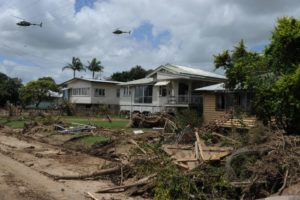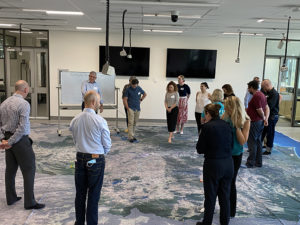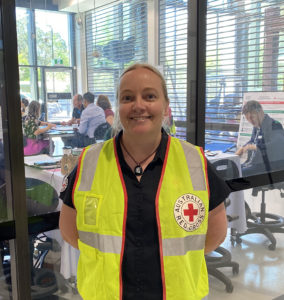Disaster management experts have gathered at Griffith University’s Nathan campus (18 and 19 October) for the inaugural Resilience in Practice Symposium, coinciding with the 10-year anniversary of the Queensland-wide floods in 2011.
Taken together with the pandemic, disaster agencies have dealt with back-to-back and often overlapping disasters of one kind or another for around 500 consecutive days, making it difficult to pause to incorporate new learnings and better develop community resilience.
Dr Piet Filet, from Griffith’s Australian Rivers Institute (ARI) and the FloodCommunity of Practice (COP) network,said whilethe disaster management cycle hada rhythm,recent times hadcertainly testedthe traditional model.
“We are accustomed to a cycle of prevent, prepare, respond, recover,thenprevent, prepare, respond, recover,known as PPRR,”Dr Filetexplained.
 “In the past that tended to be linear, providing arest for at least a season before floods come back, or at least a season before firesreturn but now,we have a constantCovid eventwith an overlay of flood and fire that isessentiallymerging,so our decision makers are always on. They have not had a break.”
“In the past that tended to be linear, providing arest for at least a season before floods come back, or at least a season before firesreturn but now,we have a constantCovid eventwith an overlay of flood and fire that isessentiallymerging,so our decision makers are always on. They have not had a break.”
The Flood COP network, and partners from state and federal government departments, non-government organisations and the insurance industry, all key players in disaster co-ordination,responseand recovery, will meet at Griffith to reflect onthe consequences of decision makingand ways to achieve greater community resilience.
Pro Vice Chancellor (Sciences) Professor Andrew Smith saidGriffith was pleased to play a pivotal role inbringing the disaster community together.
“Both through our leading research and ourstate-of-the-artinfrastructure,Griffith Universityisproud to play an important role in facilitating conversations about community resilience andways in which ourown resources,both physical and peoplecanbettersupport disaster readiness,” he said.

An image of the devastation in Grantham on January 15, 2001. AAP image by Dean Lewins courtesy of ABC News.
“We are also exploringnewdigital toolsthat canfurthersupportefforts around resilience, particularly in the area of floodprevention and preparation.”
Held over two days, the Queensland Resilience in Practice Symposium, which includes aFlood Resilience Forum,willfeatureplenary and panel sessions along with interactive scenarios so thatattendees can observe,reflectand discuss the roleplays.
On the first day of the Symposium, the Queensland Reconstruction Authority ran a recovery exercise to inform planning, preparedness and resilience.

Shoes off please! Forum participants traversed a map of greater Brisbane to better plan and prepare for major flood events.
The highlight of the Symposium’s second day of activities was the Flood Resilience Forum, which featured three interactive scenarios involving around 40 participants (delegates and actors) followed by discussion and feedback.
The activities build on previous events hosted by the FloodCommunity of Practisein March and Aprilearlier thisyear.
Dr Filet said the disaster management community inAustralia had built a strong skill set to respond and recover from major Flood events but interactive scenarios like these, providedinsights intolong-term outcomes from response and recovery efforts. This willhelp deliver greater proactive resilience.
“These events are about learning how we can translate that expertise into more proactive measures that reduce the impact of flood events, well in advance of the events occurring,” he said.
“The forecast cumulative costs of not building adaptation and mitigation measures to future flood events are prohibitive and at this event we aim to better understand the professional skills and decision making needs to enable a transition to more plan and prepare efforts, while maintaining the respond and recover expertise.”
Flood Resilience Forum scenarios:
- Response: Features of a Disaster Co-ordination Centre
- Recovery: Features of an Evacuation Centre and Recovery Hub
- Prevent,Prepareand embed Resilience: Features of Planning and Preparedness.

Eleanor Carter (Australian Red Cross) at the symposium
Australian Red Cross delivered the Recovery scenario activity. Red Cross Emergency Services State Liaison and Engagement Lead Eleanor Carter said it was a valuable opportunity to explore in greater depth the strengths and challenges of evacuation centre operations, and how they impact on evacuees.
“As a global and community-based humanitarian movement Red Cross has a long history of responding to disasters wherever they occur,” she said.
“We acknowledge the important role of communities and agencies in planning for, responding to, and recovering from disasters.
“We are pleased to support this initiative by facilitating an evacuation centre scenario, which highlights the complexities of community evacuation, and the coordinated approach required for effective response.”
The inaugural Resilience in Practice Symposiumis a joint event developed in partnership with Griffith University, the Flood Community of Practice, Suncorp, Queensland Reconstruction Authority and the National Recovery and Resilience Agency.
All sessions and experiential learning activities were run in Griffith’s newest learning and teaching facility, the Engineering, Technology and Aviation building known as N79, which features specialised laboratories,engineeringhigh baylabs with cranes and gantries,workshops, informal learning spaces,a technology floor, science super lab,a simulation studio andengagement spaces located around acentral atriumwhich can exhibitfor example,a suspended light aircraft or vehicle.

